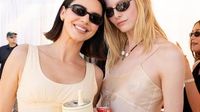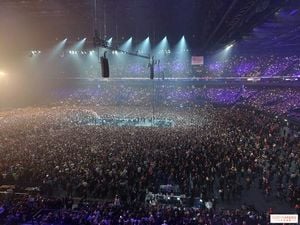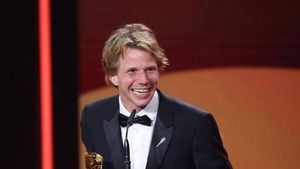As the iconic Coachella Valley Music and Arts Festival kicks off each year, its evolution from a niche gathering into a cultural phenomenon is undeniable. Once a humble festival that debuted in October 1999 for just $50, Coachella has transformed into a multi-million-dollar event, with general admission passes now starting at around $600, not including parking and additional fees. This dramatic increase in cost reflects broader changes in the festival's atmosphere and demographic, leading many to question the festival's original spirit.
Kate Beske, a 22-year-old journalism major from Destrehan, Louisiana, recalls the magic of Coachella in the mid to late 2010s, where stars like Vanessa Hudgens and Austin Butler graced the grounds. “Every time a picture was uploaded, I was in love with the fashion and whimsy of it all,” she reminisces. Alongside them, influencers like Kendall and Kylie Jenner, Selena Gomez, and Gigi Hadid blended the latest fashion trends with their unique Coachella looks, creating a spectacle that many fans eagerly anticipated.
However, Beske notes a stark shift in the festival's essence. The once-celebrated music and fashion aspects seem overshadowed by the overwhelming presence of sponsorships and influencer culture. According to an NPR article, the festival, which once resisted corporate sponsorships, is now inundated with brands eager to capitalize on its fame. Among the most notable sponsors is Rhode Beauty, owned by Hailey Bieber, which reportedly had the highest earned media value from the event. Similarly, Kendall Jenner’s 818 Tequila is another brand that has made its mark at Coachella.
Beske expresses her concerns about this commercialization, saying, “The addition of many brands hosting influencers and sponsoring the event has taken away from what Coachella was supposed to be about.” She feels that the festival, which once thrived on creativity and individuality, has become more about influencers creating content than celebrating music and fashion. This sentiment resonates with many festival-goers who long for a return to the festival's roots.
The trend of influencer culture at Coachella was further highlighted this year with Kendall Jenner's appearance in a 'milkmaid dress' at Weekend 1 of the festival. This new fashion trend, which has taken TikTok by storm, involves wearing long, flowing dresses reminiscent of pastoral life. One TikToker's video discussing the trend has garnered over 2.1 million likes and 20.6 million views, showcasing the fascination and criticism surrounding this style.
Lorynn Divita, a professor of apparel design and merchandising, offers insight into the resurgence of the milkmaid dress. She notes that fashion often reflects larger cultural and political trends. “The present is always changing − always − and fashion is very quick to respond to changes in taste that reflect modern life,” Divita says. With women's roles in society fluctuating, the return of hyper-feminine fashion like the milkmaid dress is not surprising.
Divita explains that clothing styles tend to mirror women's social standing. For example, during World War II, as women entered the workforce, fashion became more masculine. Conversely, as women returned to domestic roles in the 1950s, fashion shifted back to a more feminine aesthetic. “When we see a regression of women's social and economic advancement, we see a corresponding rise in hyper-feminine fashion,” she explains.
The name 'milkmaid dress' itself carries cultural significance, symbolizing non-threatening and nurturing qualities. Divita suggests that this aesthetic resonates with many today, providing a sense of calm amid societal chaos. “It stands in sharp contrast to the chaos that we are currently living in right now,” she says. “It's a calming, serene aesthetic, and I can see why people gravitate towards it.”
While some might wear milkmaid dresses as a political statement, many simply want to stand out in a sea of typical club attire. As one TikToker noted, “We have never had more attention in our lives than when we wore these flowy Mormon-looking outfits to the club.” This trend certainly worked for Jenner, who stood out at Coachella amidst a crowd dressed in more conventional festival attire. “Everybody else looks like they're at Woodstock, and she looks like she's at a garden party,” Divita remarked, highlighting Jenner's unique style.
However, the staying power of milkmaid dresses as club attire remains uncertain. Divita points out that fashion is always in flux and that once a trend becomes exhausted, its opposite often emerges. “We have gotten to a point with clubwear that we are so used to tight, revealing clothing that we're fatigued of it,” she explains. This fatigue may very well contribute to the rise of the milkmaid dress as a fresh alternative.
The shift in Coachella's atmosphere and the rise of new fashion trends like the milkmaid dress reflect broader societal changes. Beske’s longing for the festival's original charm highlights a collective desire for authenticity in a world increasingly dominated by commercial interests. As Coachella continues to evolve, it remains to be seen whether it can recapture the magic that once defined it.
In a landscape where fashion and culture are constantly shifting, both the festival's attendees and the wider world of fashion will continue to adapt. While some may lament the changes at Coachella, others embrace the new trends, finding ways to express their individuality and creativity amidst the noise of commercialization. As the festival unfolds each year, it offers a glimpse into the ever-changing tapestry of cultural expression, leaving many to wonder what the future holds for this iconic event.





